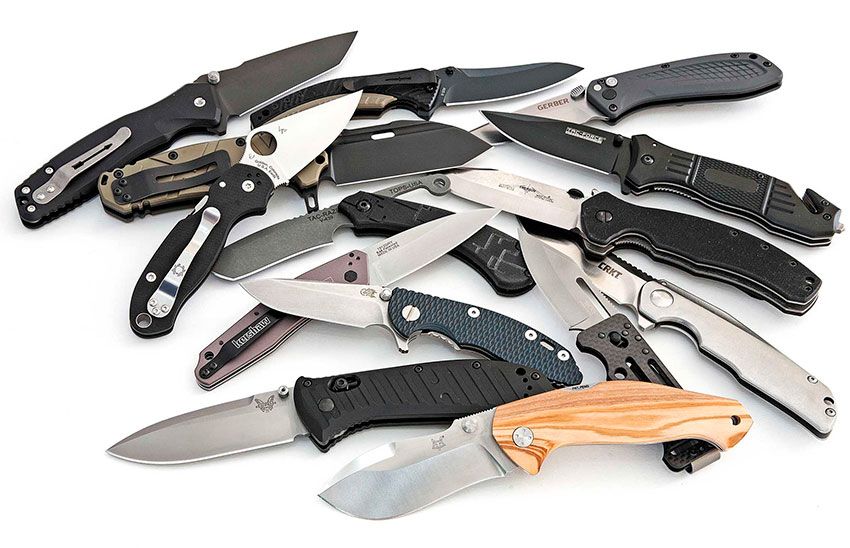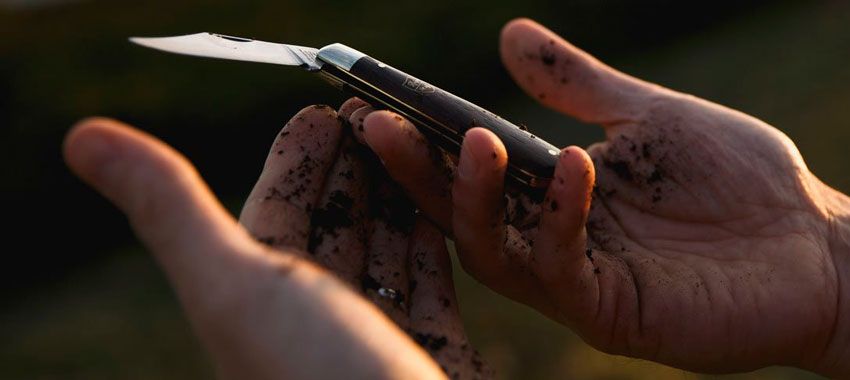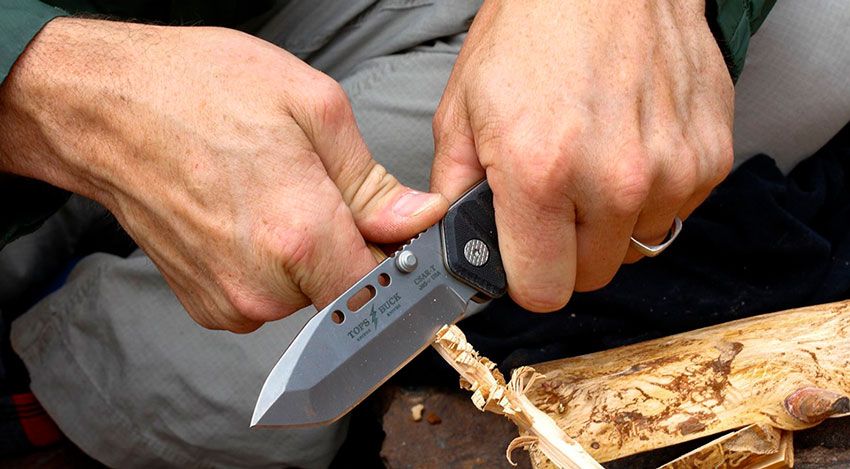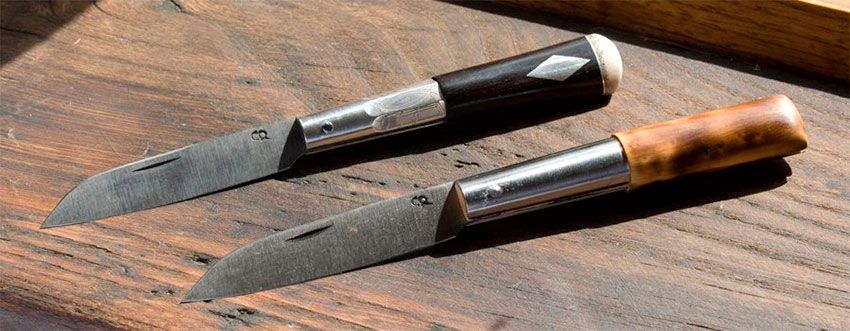Knife types
7 years ago · Updated 6 months ago

There are many types of folding knives, almost one for every use. We will explain the main ones to help you buy a folding knife.
As we know them today, pocket knives may have been with humans since time immemorial. Today, it seems that part of society wants to marginalize them, even penalizing the act of carrying a folding knife with us.
In times not so long ago, the use and carrying of a folding knife was widespread, and it was as common to carry a folding knife as it was to carry a wallet or a watch. Mainly in certain professional activities such as fishermen (to remove hooks from the fish they caught), farmers, woodcarvers, hunters (to cut up their prey), scribes (to sharpen pencils or quills), basket weavers (to cut and even out wicker), etc.
Today, there are still many reasons to continue using these small tools. In some areas, such as camping, they are indispensable, but there are certain situations in which using a Swiss Army knife can even help save lives. This is the case with emergency knives used by law enforcement. These knives are capable of cutting a vehicle's seat belt in the event of an accident.
Their use as a cutting tool is more than justified, especially in places where we don't have access to other tools, such as in the countryside.
Using a hunting knife to cut food is essential for mushroom-picking lunches in the mountains.
Carrying a knife can help us carry out small repairs, such as unscrewing or screwing, stripping electrical cables, or cutting pieces of polystyrene, cardboard, etc.
As you can see, there are many and varied reasons for using a pocket knife. We will list the different types of folding knives that exist, their characteristics, and the functions they perform and for which they were designed.

Types of pocket knives, uses, and characteristics
There are many types of pocket knives available. There is almost one type of pocket knife for every activity. This is due to the specialized functions that each model of folding knife can perform.
Thus, we can mainly find these types of pocket knives according to their use:
- Hunting knives: these are generally large knives, although pocket knives are also used. They are characterized by a very fine point and a wide, sharp blade, which allows the meat to be cut into pieces.
- Fishing or sailing knives: these are characterized by the absence of a tip. This is to prevent accidents in an environment such as a boat or the sea, which is always in constant motion. If used to remove fish hooks or to help repair nets, fishing knives incorporate tools specific to these functions.
- As we are mushroom specialists, mycological knives or special knives for picking porcini mushrooms or milk caps are a must. This is another highly specialized type of knife that has become very popular in recent years thanks to the boom in mycology. Its main features include a brush for cleaning mushrooms, a curved blade similar to a carving knife, and two types of blade, one smooth and one serrated. Other features include a measuring tape or a hook for attaching the knife to a basket or backpack.
- Razors. A very distinctive shape, without a sheath and with a very sharp, rectangular cutting surface.
- Rescue knives: these incorporate a seatbelt cutter and a special blade for cutting these items without injuring the person still wearing them. They usually have a curved blade with a slightly serrated edge
- Multifunction knives or Swiss Army knives. A veritable toolbox that incorporates many functions, from a magnifying glass to a ruler or compass, as well as various screwdrivers, pliers, and scissors. They usually have different blades for each function: cutting, sawing, etc.

- Harvesting or gardening knives. These are characterized by their strength and their special curved blade, which allows them to cut plants while adapting to their curved shape. Also known as trimming knives, they are widely used in the fields for harvesting mushrooms.
- When it comes to military knives or tactical knives, there is a wide range of these types of knives available. This is because they have become widespread due to their enormous versatility. Among their characteristics are a thicker blade that still retains some flexibility to prevent breakage.
They also feature different types of blades, such as smooth blades and serrated blades, which allow for a wide range of uses. - Sports knives (cycling, skating, golf, etc.). Depending on the type of sport, they include tools that help us repair our equipment.
- Diving knives. These knives are designed to cut items that may become entangled in fins or diving equipment, which is why they have a serrated edge for sawing through items such as fishing nets. The handle is made of synthetic material and these knives can be carried attached to the leg using a special sheath.
- Collector's knives. These are special editions of classic models. Their shape depends on the model being reproduced.
- Truffle knives or Truffle knives. Specially designed for collecting and cleaning truffles. Accessories for truffle hunting are special because they do not resemble traditional knives or blades, although there are specific models of folding knives. Their characteristic shape, similar to a small shovel, allows us to extract the mushroom from the ground, which is why they must be very sturdy.
- Survival knives. Another large group of knife types, where one of the main characteristics is the length of the blade. It is common to find knives up to 15 cm long. They are generally used for hunting, thanks to their resistance.
- Butterfly knives. They have a typical handle divided into two halves, which swing and are fixed at the base. They are opened with a quick, circular movement of the hand holding the butterfly knife. Their blade is smooth, thin, and pointed
- There is a final group that includes other types of professional knives. These are knives that incorporate one or more tools specific to a trade. For example, a screwdriver or wire stripper in the case of an electrician's knife. The range is very wide and there are many variations and shapes.
There are certainly many other varieties, but they could be grouped into these types. Another way is to group them by the shape of each knife. Here too, there are different types.

Types of pocket knives according to shape
We have already mentioned that thanks to the long tradition of using pocket knives, there are many different shapes of these folding knives. Each one was created to fulfill a specific function, which is why they differ in appearance from the rest. This is due to the skill of the knife maker who chooses to give a particular shape to their creations.
There are different shapes of knives, such as:
- Stylet knives
- Fan knives
- Multifunction pocket knives
- Goat knives
- Gardening knives
- Pruning shears

Other types of pruning shears according to their origin
As we have mentioned, there are different types of pocket knives depending on the geographical area where they are manufactured. Thanks to the long tradition of cutlery making, there are certain areas where pocket knives and knives continue to be manufactured according to traditional designs. Among traditional pocket knives, there are also some significant types, such as these examples:
- Albacete pocket knives
- Taramundi pocket knives
- Extremaduran knives
- Damascus knives
- Laguiole knives
- Jerez knives


Te pueden interesar